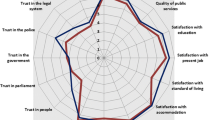Abstract
The Malaysian Quality of Life Index (MQLI) released by the Economic Planning Unit (EPU), has led authors to search for alternative method of expressing this index. One of the limitations in MQLI computations is the failure to recognise unequal weights for each accounted component. This paper offers a new way of expressing the quality of life index using a mathematical modelling based on fuzzy sets theory and the proposed weights based on Maslow’s theory of hierarchical human needs. The indices of 11 components that were used to compute MQLI, again be gathered as a basis in expressing a new Malaysian Fuzzy Quality of Life Index (MFQLI). The new indices for each component yielded through a normalisation process prior weighting and aggregation to compose a new MFQLI. It was found that a fuzzy sets approach with the inclusion of weights based on human needs yielded a better index of quality of life than the MQLI.



Similar content being viewed by others
References
Aziz, J. (2005). Multi-criteria index development. In M. T. Abu Osman (Ed.), Mathematics and society (pp. 17–26). Kuala Terengganu: KUSTEM.
Bonner, J. (1986). The introduction to the theory of social choice. Baltimore: The John Hopkins University Press.
Bourguignon, F. (2004). The effect of economic growth on social structures. In P. Aghion & S. Durlauf (Eds.), Handbook of economic growth. Washington, DC: World Bank.
Canos, L., & Liern, V. (2008). Soft computing-based aggregation methods for human resource management. European Journal of Operational Research, 189(3), 669–681. doi:10.1016/j.ejor.2006.01.054.
Cerioli, A., & Zani, S. (1990). A fuzzy approach to the measurement of poverty. In Dagum, C. and Zenga, M. (eds) Income and wealth distribution, inequality and poverty, studies in contemporary economics, pp. 272–84. Berlin: Springer Verlag.
Clarke, M., Islam, S., & Paech, S. (2003). Australia’s well-being based on hierarchical needs. Paper presented at 5th Australian conference on quality of life, Deakin University, Melbourne.
Clarke, M., & Islam, S. (2004). Economic growth and social well-being: operationalising normative social choice theory. Amsterdam: North Holland.
Dasgupta, A., & Pearce, D. (1972). Cost-benefit analysis. London: Macmillan.
Department of the Environment (DOE).Malaysia. (1996). Malaysia environmental quality report. Kuala Lumpur: Government Press.
Economic Planning Unit (2004). Malaysian quality of life, Kuala Lumpur: Government Press.
Economic Planning Unit. (2007). Vision 2020. Prime Minister’s Department, Malaysia. Retrieved May 4, 2007. from http://www.epu.jpm.my/new%20folder/vision.htm.
Ferrans, C. (1996). Development of a conceptual model of quality of life. Scholarly Inquiry for Nursing Practice: An International Journal, 10(3), 293–304.
Ferrans, C. E. (1990). Development of a quality of life index for patients with cancer. Oncology Nursing Forum, 17(3), 15–19.
Ferrans, C., & Powers, M. (1985). Quality of life Index: Development and psychometric properties. ANS. Advances in Nursing Science, 8, 15–24.
Hagerty, M. (1999). Testing Maslow’s hierarchical of needs: national quality of life across time. Social Indicators Research, 46, 249–271. doi:10.1023/A:1006921107298.
Jia, W.W., Ching, H.C., & Kun, C.H. (2008). Fuzzy hierarchical TOPSIS for supplier selection. Applied Soft Computing, Article in Press.
Lazim, M. A., & Abu Osman, M. T. (2008). Quality of life index of three selected states in the Peninsular Malaysia: Fuzzy sets approach. International Journal of Ecological Economics and Statistics, 11(8), 90–99.
Maslow, A. (1970). Motivation and personality (rev. ed.). New York: Harper & Row.
Maslow, A. (1971). The farther reaches of human nature. New York: Viking Press.
Miceli, D. (1998). Measuring poverty using fuzzy sets, national centre for social and economic modelling. Canberra, Australia: University of Canberra.
Nussbaum, M. (2000). Women and human needs. Oxford: Oxford University Press.
Ragin, C. C. (2000). Fuzzy set social science. Chicago: The University of Chicago Press.
Sen, A. (1985). Commodities and capabilities. Amsterdam: North Holland.
Sen, A. (1987a). The standard of living: Lecture I, concepts and critiques. In G. Hawthorn (Ed.), The standard of living. Cambridge: Cambridge University Press.
Sen, A. (1987b). The standard of living: Lecture II, lives and capabilities. In G. Hawthorn (Ed.), The standard of living. Cambridge: Cambridge University Press.
Sirgy, M. (1986). A quality-of-life theory derived from Maslow’s developmental perspective. American Journal of Economics and Sociology, 45(3), 329–342. doi:10.1111/j.1536-7150.1986.tb02394.x.
Smithson, M., & Verkuilen, J. (2006). Fuzzy set theory: An application in the social sciences. California: Sage Publications, Inc.
Szeles, M. (2004). Multidimensional Poverty Comparisons within Europe: Evidence from the European Community Household panel. IRISS Working Paper Series No. 2004-05. IRISS at CEPS/INSEAD.
Warnecke, R., Ferrans, C., & Johnson, T. (1996). Measuring quality of life in culturally diverse populations. Journal of the National Cancer Institute. Monographs, 20, 29–38.
Ying, M. W., & Parkan, C. (2006). Optimal aggregation of fuzzy preference relations with an application to broadband internet service selection. European Journal of Operational Research, 187(3), 1476–1486.
Zadeh, L. A. (1965). Fuzzy set. Information and Control, 8, 338–353. doi:10.1016/S0019-9958(65)90241-X.
Author information
Authors and Affiliations
Corresponding author
Rights and permissions
About this article
Cite this article
Lazim, M.A., Abu Osman, M.T. A New Malaysian Quality of Life Index Based on Fuzzy Sets and Hierarchical Needs. Soc Indic Res 94, 499–508 (2009). https://doi.org/10.1007/s11205-009-9445-6
Received:
Accepted:
Published:
Issue Date:
DOI: https://doi.org/10.1007/s11205-009-9445-6




